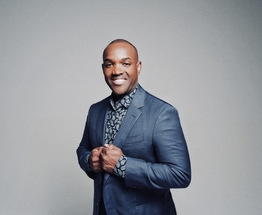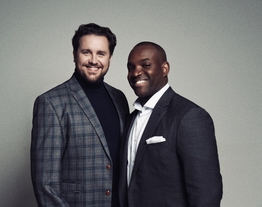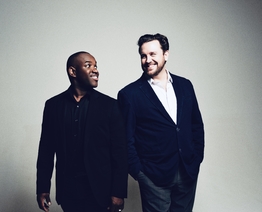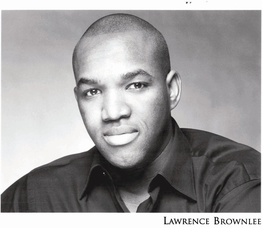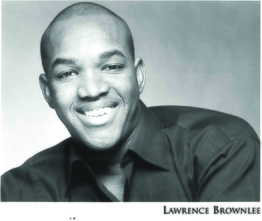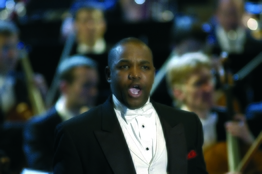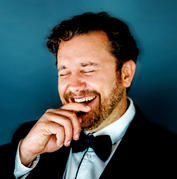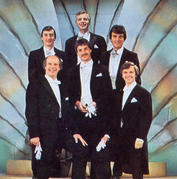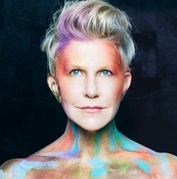Two of today’s most brilliant tenors, Michael Spyres and Lawrence Brownlee, celebrate the art of the trailblazing star singers of Rossini’s time. Amici e Rivali – ‘Friends and Rivals’ – comprises arias, duets and trios from seven of the composer’s operas, written between 1815 and 1826: the most famous comic opera of them all, Il barbiere di Siviglia, and six serious dramatic works Otello, Armida, La donna del lago, Elisabetta, regina d'Inghilterra, Le Siège de Corinthe, and, the rarest title here, Ricciardo e Zoraide.
If the spotlight is on the two American stars – not least as they assume the roles of ‘duelling tenors’ – they are in excellent company: there are guest appearances from the effervescent Irish mezzo-soprano Tara Erraught and the prize-winning young Spanish tenor Xabier Anduaga, and the recording was made at the artistic home of conductor Corrado Rovaris and I Virtuosi Italiani, the Teatro Ristori in Verona.
All the works represented on Amici e Rivali – except for Barbiere, which was first seen in Rome – have their roots in the San Carlo opera house in Naples. (While Le Siège de Corinthe was in fact written for Paris, it derived from Maometto II, premiered six years earlier at the San Carlo.) Rossini conceived them for specific singers, several of whom became defining forces in musical history: the tenors Andrea Nozzari, Giovanni David, Manuel García, Louis Nourrit and Adolphe Nourrit (a father/son pairing), Giuseppe Ciccimarra and Claudio Bonoldi, and the baritone Luigi Zamboni, who created the role of Figaro.
Michael Spyres and Lawrence Brownlee first sang together in 2018 at the Concertgebouw in Amsterdam, where their spectacular programme – bristling with stratospheric top notes and cascades of coloratura – included three Rossini duets.
As Michael Spyres explains: “Larry and I have known each other for over a decade but we never had the chance to work with each other until Amsterdam. I have always admired Larry’s singing and had wanted to do a programme showcasing this amazing music written for the greatest Rossini tenors. Larry was just as thrilled and so we put our heads together to come up with a programme. Not only does Larry possess one of the greatest voices and techniques, but he is an amazing performer – you have to sing your best just to keep up with him! After the major success we had in Amsterdam we realized just how much the public appreciated our efforts and we realised that most people don’t actually know about this special time in the history of opera when two tenors would duel on stage for the hearts of the music-goers.”
Lawrence Brownlee explains how their vocal chemistry works: “Our voices complement each other because they have similar qualities to the voices that Rossini wrote for – voices which worked together. They are of similar range, but very different vocal colour, though we can both handle the challenges of high-lying legato and coloratura. My voice has been characterised as a leggiero or light-lyric tenor, like Giovanni David’s. Michael’s is a lyric tenor, or maybe more specifically a so-called ‘baritenor’, with a darker character, like Andrea Nozzari’s.” David and Nozzari sang together in the first performances of Otello, La donna del lago and Ricciardo e Zoraide.
“The duets that Rossini wrote for very different tenors precisely highlight our vocal strengths,” affirms Spyres. “Larry’s voice is a natural tenor voice and the clarity, beauty and virtuosity of his singing come through abundantly in this repertoire. Conversely, I began as a baritone and my natural voice lies much lower – almost everyone asks if I am a baritone when they hear my speaking voice! The vocal writing for Nozzari feels like it was composed for me. I have never found a closer fit to my natural colour and technique. It was made to fit the character of a warrior and it contrasts wonderfully with the writing for Larry’s voice type. With this programme we have probably set a record with our myriad high notes, but the music written for Nozzari also frequently goes to the lowest reaches of the baritone range.”
Brownlee and Spyres have impeccable credentials in the bel canto repertoire of the early 19th century. “I believe that what we are doing as musicians is not dissimilar from what one might have heard many years ago in a theatre in Italy,” says Brownlee. “We have both been schooled in the traditional bel canto style and we have both worked with conductors, teachers and coaches who are experts on Rossini.” Spyres asserts that “Larry and I would not have a career today had it not been for the singers, conductors, and scholars who have paved the way for us over the past 50 years, during which Rossini has enjoyed an incredible renaissance.” He cites his collaborations with Rossini specialists like tenor Raúl Giménez, musicologist Phillip Gossett and scholarly conductors David Parry, Will Crutchfield and Alberto Zedda. The Rossini credentials of Bergamo-born Corrado Rovaris – conductor for Amici e Rivali, Music Director at the Opera Company of Philadelphia and Principal Conductor of I Virtuosi Italiani – were established early in his career with appearances at the Rossini Opera Festival in Pesaro, the composer’s birthplace on Italy’s Adriatic coast.
“One of the most wonderful aspects of bel canto practice is the obligation and freedom to improvise and to create your own cadenzas and variations, continues Spyres. “No composer wrote more demandingly of a singer than Rossini did for the tenor – Bellini, Donizetti, and Berlioz being the only occasional exceptions. In many of Rossini’s operas there is no baritone role, and one could even claim that Rossini was the only composer to exploit so many shades of the tenor voice. In truth, much of his writing for tenor set the boundaries for what the male voice could achieve.”
Brownlee points out that “the genius of Rossini in being able to create such different characters within the same vocal range,” but he also observes the closeness of tenor and baritone in the duet ‘All’idea di quel metallo’ from Il barbiere di Siviglia, in which he sings the tenor role of Almaviva – written for Manuel García – and Spyres takes the baritone role of Figaro: “Figaro’s lines are only just slightly lower than Almaviva’s,” he observes. Michael Spyres expands on this point: “Before and during Rossini’s reign it was quite common for singers to perform both baritone and tenor roles, and these include Giacomo David, Andrea Nozzari and, indeed, Manuel García, who took Paris by storm when he sang Mozart’s Don Giovanni [a role generally assigned to baritones, bass-baritones and even basses].”
The 15 items on the programme of Amici e Rivali have been organised to follow the musico-dramatic structure of a Rossini opera, as Spyres explains: “Overture, introduction of primary characters and secondary characters, presentation of conflict, resolution … We also chose to suggest a chronological progression through Rossini’s career in order to show the diversity of his evolution as a composer, and to reveal how he influenced everyone who came after him.”
Some of the pairs of tenor characters are friends, others are rivals, but what is the relationship between two tenors when they are striking sparks off each other?
“We are friends!” asserts Lawrence Brownlee. “Any rivalry is just sportsmanship and theatrics. Beyond enjoying our musical performances, audiences at our concerts have praised the way we create a positive and supportive atmosphere on stage.”
“We are definitely friends,” confirms Michael Spyres. “Though I must admit that, when singing Otello, I have not come across a mightier foe! Larry is so good that he forces you to sing on a higher level. Though he and I are very good-natured, a little rivalry is necessary to raise the stakes and this is why we are a winning combination. Larry and I won’t back away from any vocal duel and we will always let the vocal fireworks fly!”
Spyres’ final word, though, is for Rossini. “This music really gives the listener a sense of the diversity and complexity of the male voice. I find the symbiosis between the vocal and orchestral components to be unrivalled. Rossini’s combination of vocal writing, complexity of composition, and sheer musical beauty will live on as long as opera itself.”

